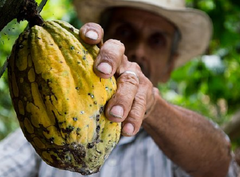Exploring the richness of cocoa [06.03.23]
Cocoa and the range of products derived from it are known for their rich and complex taste and composition. In addition to fats and proteins, cocoa contains a variety of secondary plant compounds such as polyphenols, methylxanthines, fatty acids, phenolic acids, vitamins, minerals, peptides, N-phenylpropenoyl amino acids, biogenic amines and more. Both the composition of cocoa and its bioavailability, absorption and metabolism are influenced by various factors, such as the genetics of the cocoa plant, the terroir (its growing environment), processing and formulation. The consumption of cocoa and its products can potentially be beneficial to health, especially when high levels of flavonoids prevail. However, the complex relationships between cocoa consumption and health need to be explored in more detail. This book chapter examines the composition of cocoa and its changes during post-harvest and processing steps, as well as the relationship between composition and detected metabolites in plasma and urine after cocoa consumption. Physiological mechanisms with a particular focus on cardiovascular performance are also discussed and indications for clinical interventions with cocoa and cocoa products are given.
Original Book Chapter
Abstract
Cocoa and cocoa derivatives are recognized for having a rich and complex nature. This is highly dependent on the cocoa genetics, on the terroir where cocoa is produced and processed, on the different transformation steps and on the final formulation of the product. Fats and proteins can constitute the highest percentage of different cocoa products, in addition a great variety of phytochemicals can be found, as for example, polyphenols as flavonoids, methylxanthines, fatty acids, phenolic acids, vitamins, minerals, peptides, N-phenylpropenoyl-l-amino acids, biogenic amines, among others. After intake, the bioavailability, absorption, metabolism, and excretion of these phytochemicals are mainly influenced by several factors as nature and dose of the phytochemicals, food matrix and interactions with other metabolites, subject profile and its overall health status and interactions with the microbiota. During these processes, a series of transformations lead to the production of metabolites which might exert biological activity with different implications. Increasing evidence shows that cocoa and derivatives intake has a potential role in health promotion suggesting acute positive effects over vascular parameters and cardiovascular performance, especially when containing significant amounts of flavonoids. Nonetheless, the relation between cocoa intake and health must be done with integrative approaches. This chapter aims to review the cocoa and cocoa derivatives composition, and its change during postharvest and processing steps. Furthermore, the relation between composition and metabolites reported in plasma and urine after intake of cocoa and cocoa products is shown. A review of some of the physiological mechanisms associated with the presence of metabolic products is addressed, with special focus on cardiovascular performance. Finally, evidence is presented regarding clinical interventions with cocoa and cocoa products, emphasizing cardiovascular health.
- Introduction
- Cocoa processing
- 2.1. Postharvest processing
- 2.2. Industrial processing
- Cocoa composition: main cocoa components and their dependence on processing
- 3.1. Other phytochemicals
- Bioavailability and metabolism of cocoa phytochemicals
- Cocoa phytochemicals and cardiovascular performance: Biochemical and physiological-associated mechanisms
- Clinical interventions with cocoa and cocoa products: addressing cardiovascular performance
- Closing remarks
- References
© 2023 Elsevier Inc. All rights reserved.
More about the author and the Department of Food Biofunctionality
 | Dr. Alexander MONTOYA ARROYO
Postdoctoral Researcher |
 | Prof. Dr. Jan FRANK
Head of Department |


